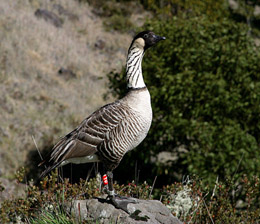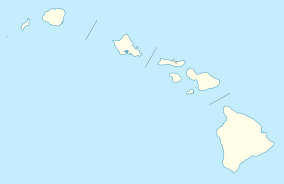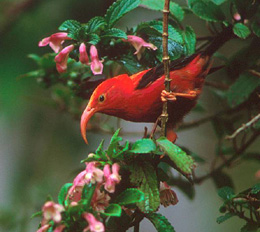Hakalau Forest National Wildlife Refuge facts for kids
Quick facts for kids Hakalau Forest National Wildlife Refuge |
|
|---|---|
|
IUCN Category IV (Habitat/Species Management Area)
|
|

Nene - Hakalau Forest NWR.
|
|
| Location | Island of Hawaiʻi |
| Nearest city | Hilo, Hawaiʻi |
| Area | 38,047 acres (15,397 ha) |
| Established | 1985 |
| Governing body | United States Fish & Wildlife Service |
| Website | Hakalau Forest National Wildlife Refuge |
The Hakalau Forest National Wildlife Refuge is a special protected area on the Big Island of Hawaiʻi. It's a place where unique Hawaiian plants and animals are kept safe. This refuge is part of a bigger group called the Big Island National Wildlife Refuge Complex, which also includes the Kona Forest National Wildlife Refuge. Some parts of the Kona Forest are closed to visitors because they are home to very rare and endangered species.
Contents
What is Hakalau Forest Like?
Hakalau Forest National Wildlife Refuge has some of the best native wet forests left in Hawaiʻi. If you go to lower areas, below 4,000 ft (1,200 m), it rains a lot – about 250 in (6,400 mm) every year! This wet area has bogs, fern patches, and thick forests with many deep valleys.
As you go higher, above 4,500 ft (1,400 m), the rain slows down to about 150 in (3,800 mm). Here, you'll find amazing koa (Acacia koa) and ʻōhiʻa lehua (Metrosideros polymorpha) trees. These trees grow so tall that their tops form a thick canopy, like a roof over the forest.
Even higher up, above 6,000 ft (1,800 m), it's much drier, with less than 100 in (2,500 mm) of rain. The native forest here slowly changes into old pastureland. This land used to be for cattle, and now it's mostly covered by grasses and weeds that aren't native to Hawaii. Since 1989, people have planted over 400,000 koa, ʻōhiʻa, and other native trees in this area to help the forest grow back. This is part of a big reforestation program.
The Hakalau Forest Unit was created in 1985. It covers 32,733 acres (132.47 km2) on the eastern side of Mauna Kea volcano. Later, in 1997, the Fish and Wildlife Service bought more land to create the Kona Forest Unit. This unit is on the western side of Mauna Loa volcano, between 2,000–6,000 ft (610–1,830 m) high. The Kona Forest Unit was made to protect the home of the ʻalalā (Corvus hawaiiensis). Sadly, this bird is now extinct in the wild, meaning it no longer lives freely in nature.
Protecting Rare Animals
Many of Hawaii's native animals have lost their homes over time. When people first arrived, and later when Europeans brought animals like cattle, goats, and pigs, they changed the forests. Hundreds of new plants, animals, and insects were also brought in.
Today, many plants you see, like orchids, gingers, and plumeria, are not native to Hawaii. Animals like mosquitoes, wasps, small Asian mongooses, cats, and rats have also harmed Hawaii's natural places and its native species.
In Hakalau Forest, cattle and pigs have eaten many native Hawaiian plants. This has allowed other grasses and shrubs to take over. Even where the native trees are still strong, the plants growing underneath them have often been replaced by non-native ones like blackberry and English holly.
The refuge is a safe place for many rare creatures. Eight of the 14 native bird species living here are endangered. This means they are at risk of disappearing forever. You can also find 13 types of migratory birds and the endangered ʻopeʻapeʻa (Hawaiian hoary bat, Lasiurus cinereus semotus).
Saving Special Plants
Hakalau Forest is also home to 29 rare plant species. Twelve of these are currently listed as endangered. For example, two types of endangered lobelias have fewer than five plants left in the wild! The refuge works hard to protect these unique plants.
Visiting Hakalau Forest
If you want to visit Hakalau Forest National Wildlife Refuge, only the Upper Maulua Unit is open to the public. Here, you can enjoy activities like hiking, watching birds, and taking pictures. All other parts of the refuge are closed to protect the sensitive wildlife.
You can visit the Upper Maulua Unit on Saturdays, Sundays, and holidays, from sunrise to sunset. However, you need to make a reservation before you go. You can call the Hakalau Forest NWR office at least one week ahead of time to book your visit.



